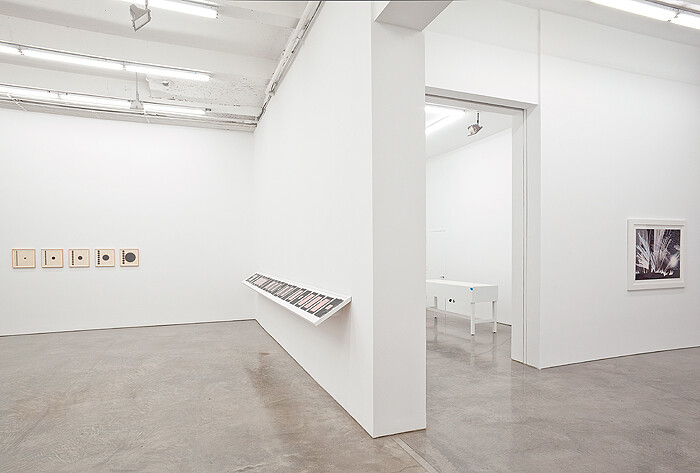“Am I going haywire? Seriously. Am I going to finish the goddamn thing?” Hollis Frampton was frequently anxious about his monumental Magellan film project. “If you don’t finish an epic poem it is a more or less magnificent ruin,” he said. “This I probably have got to finish or I have blown the whole thing, in my own mind, since it has the problem of establishing its own context.” Frampton’s decade of work was cut short by his death in 1984, and his 36-hour-long “resynthesis of the film art” remains incomplete.
Magellan is one of the many “unfinished” film works featured in Gladstone Gallery’s current summer show, which is guest-curated by Thomas Beard, who is better known as co-director of New York’s experimental film venue Light Industry. In its own subjective way, the exhibition provides Frampton’s work with precisely the kind of context he couldn’t have dared to hope for—a selective take on film history that is both informed and open-ended. The central element of the show is the black box space, where films are projected according to a weekly schedule, starting at 3 pm daily. The rest of the gallery is host to a small group of objects related to the films, ranging from storyboards and scripts to diagrams and drawings.
From the debut film of the exhibition, it became clear that the notion of an “unfinished” work is not as straightforward as it may sound: in Morgan Fisher’s The Director and His Actor Look at Footage Showing Preparations for an Unmade Film (2) (1968), the “unmade film” of the title is in fact the film we are seeing (which shows the unmade film being made). At the other end of the spectrum, Pier Paolo Pasolini’s Notes for an African Orestes (1970) was never intended as anything but a what-if proposition—what if Aeschylus’s Greek tragedy were to be restaged in contemporary Africa? And even though Jean-Luc Godard and Anne-Marie Miéville’s Ici et Ailleurs (1976) did manage to coax a film out of Godard’s footage of PLO camps, the finished work seems to be about the very impossibility of that task.
Taken together, the films and objects on view examine the poetry of film as a concept, as a document of the moment when an idea represents potential. A small 1936 sketch by Dziga Vertov, for example, is a chart for a “creative laboratory” intended as a permanent base for Soviet filmmakers and an archive of their work—a proposal both beautifully pragmatic and highly impossible in 1930s Russia. A suite of meticulous, colored grids by Paul Sharits are all that exist of the “film” Passare (1988), revealing the affinities between his structural film works, musical notation, and painting. The storyboard drawings for Kenneth Anger’s Puce Women (ca. 1949), of which only a six-minute short, Puce Moment, was ever realized, gives the viewer a sense of his Ernst Ludwig Kirchner-meets-Louis B. Mayer vision for the film.
The catalogue published to accompany the show expands the textual web of references, starting with Sergei Eisenstein’s “Notes for a Film on Capital,”(“a new work on a libretto by Karl Marx”) and ending with Giorgio Agamben’s take on Don Quixote (“The Six Most Beautiful Minutes in the History of Cinema”). The films, catalogue texts, and objects are parallel and interwoven works: it is only after reading Oskar Fischinger’s 1932 essay, “Sounding Ornaments,” that we realize the shapes running down the side of his eponymous ink drawings in the gallery are intended to be “drawn music,” or a graphic basis for sound.
While much more can be said of the works on view, the exhibition’s most commendable aspect may be its modest scale. Despite the epic ambitions of many of the films’ directors, the screening schedule is quite manageable, with only an hour or two of material grouped together per day, and occasional repeated showings on different days of the week. The show avoids the marathon cycles that increasingly characterize contemporary art events, betraying an almost old-fashioned respect for attentive viewing. This sensitivity to the time and space demanded by the cinematic medium, regardless of its state of completion, defines the show’s curatorial approach. The sparse and thoughtful installation of the three galleries gives viewers time to look, read, and imagine what may have been—to finish the work, as Frampton once suggested, in the mind.




